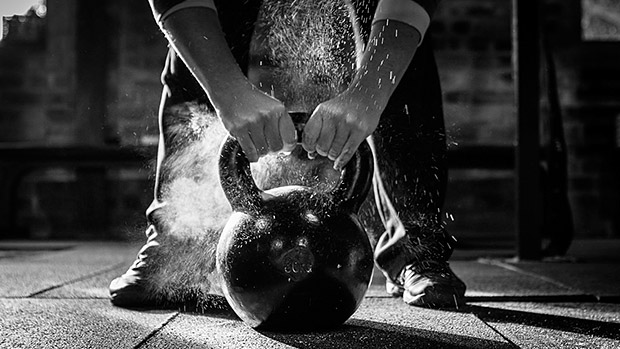Although you're probably tired of hearing about "secret" Soviet training programs, the Soviet track and field teams really were dominant in the Olympics. One reason is the work of obsessive sport scientist Yuri Verkhoshansky who created a hugely successful training protocol based on jumping drills.
He'd have athletes drop from 60-inch boxes in what he called "depth jumps." Specifically, an athlete drops off a box, lands briefly to absorb the shock, and then immediately jumps as high as possible, which led to a 14% increase in maximal strength among highly-trained volleyball players.
Even so, I wouldn't recommend them for most athletes unless they've got great squat form and strength. There are, however, safer alternatives.
We can activate the same beneficial mechanisms found in the depth jump with Russian kettlebell swings. How? By placing an emphasis on the downward (eccentric) portion of the swing.
Instead of absorbing the weight of our own body, as we do in depth jumps, we absorb the shock of the kettlebell when it switches directions. The more we force the kettlebell down, the greater the plyometric effect.
In the lab, Brandon Hetzler found that experienced kettlebell instructors could swing a 32-kilogram kettlebell back down with a force equivalent to three times their bodyweight. Most of the beneficial effects of kettlebell swings come from when we reverse force, so the more force there is to reverse, the more strength (and explosiveness) we'll gain.
Kettlebell swing over-speed eccentrics can be done in three ways.
- Accentuate the Eccentric: Normally, we let the kettlebell float into position and let gravity take it back down into our next swing. However, we can actively accelerate it downward by forcefully "throwing it" between our legs.
- Partner Assisted Downward Throw: In this scenario, we have a person stand on the side and push down on the kettlebell when it reaches the top.
- Band Assisted Eccentric: This version involves wrapping a band around the kettlebell and standing on the band. Once the kettlebell hits the top of the swing, the band accelerates the kettlebell back down.
Don't do these over-speed eccentrics with higher reps. You're taxing the nervous system a lot more than you would with regular swings. Ten or fewer reps is a good rule of thumb.
Verkhoshansky also created multiple apparatuses to create a similar "depth jump" effect with the upper body. Picture a bench-press type device that drops the weight down on top of you and then allows you to explode it up. (Please don't try creating this type of gizmo at home as Verhoshansky's device had built in safety features.)
However, we can mimic this effect with drop push-ups.
To do these, create a stable base of about 12 inches high, just outside your normal push-up stance.
- Position yourself atop the stable base.
- Drop off the base.
- Catch yourself (and simultaneously absorb some plyometric force) before you do a face plant.
- Explosively push up as quickly as possible (similar to the depth jump).
- Once the rep is finished, place both hands back on the base and start the next rep.
Doing this type of "depth jump" training can build enormous amounts of explosiveness. It can also serve as a nice adjunct to your traditional training by providing a bit more explosive power.
For most people, I'd suggest doing the following program to break out of your plateaus. It takes about 6-10 minutes and should be done three times a week.
A note of caution, though – this program is only for trained athletes who exhibit good control of their movements:
- On odd minutes, do 10 kettlebell swing over-speed eccentrics.
- On even minutes, do 10 drop push-ups.
- Continue back and forth for the prescribed number of rounds.
- On Mondays: 6 rounds
- On Wednesdays: 10 rounds
- On Fridays: 8 rounds
There are three main reasons why kettlebell swing over-speed eccentrics and drop push-ups (and depth jumps, of course) build explosiveness and strength:
- Greater CNS Stimulation: The shock of the sudden reversal of force leads to greater muscular excitation. The more frequent the muscle nerves fire, the more strength you build.
- Myotatic Reflex: As the muscle lengthens, the muscle spindle is stretched and its nerve activity increases. Powerlifter Andy Bolton utilizes this reflex. He performs three hamstring stretches immediately prior to executing the lift, performing the lift on the execution of the third stretch.
- Neurogenic Effects: These occur when the time between stretching the muscle and the subsequent shortening decreases as the pre-motor cortex anticipates the shock. This means our reflexes get faster.
In general, the more we do these plyometric-type movements, the more our body builds explosive power. This explosive power can help our absolute strength (deadlift), speed strength (clean), and pure speed (sprinting).
Basically, we're learning to load our muscles with potential energy for later release. These movements could be quite helpful for any sports that incorporate lots of changes of direction as well.
- Cook CJ et al. Three Weeks of Eccentric Training Combined With Overspeed Exercises Enhances Power and Running Speed Performance Gains in Trained Athletes. J Strength Cond Res. 2013 May;27(5):1280-6. PubMed.
- Isner-Horobeti ME et al. Eccentric Exercise Training: Modalities, Applications and Perspectives. Sports Med. 2013 Jun;43(6):483-512. PubMed.
- Santello M. Review of Motor Control Mechanisms Underlying Impact Absorption from Falls. Gait Posture. 2005 Jan;21(1):85-94. PubMed.
- Turner AN et al. The Stretch-Shortening Cycle: Proposed Mechanisms and Methods for Enhancement. Strength and Conditioning Journal. 2010 Aug;32(4):87-99.
- Verkhoshansky YV. Are Depth Jumps Useful. Track and Field. 1967;12(9).
- Verkhoshansky YV et al. Principles of Planning Speed and Strength/speed Endurance Training in Sports. National Strength and Conditioning Association Journal. 1989 Apr;11(2):58-61
- Yessis M. Kinesiological Research in the Soviet Union. Journal of Health, Physical Education, Recreation. 1972;43(1):93-98.





